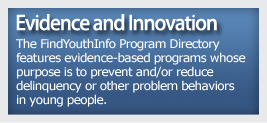Effectiveness of Positive Youth Development Programs
Positive youth development programs engage young people in intentional, productive, and constructive ways, while recognizing and enhancing their strengths. These programs promote positive outcomes by providing opportunities, fostering positive relationships, and giving the support needed to build on their strengths as well as prevent risky behaviors.
Research indicates that young people who are surrounded by a variety of opportunities for engagement encounter less risk and ultimately show evidence of higher rates of successful transitions into adulthood (Alberts, Chase, Naudeau, Phelps, & Lerner, 2006; Bandy & Moore, 2009; Eccles & Gootman, 2002; Roth & Brooks-Gunn, 2000; Pittman, Irby, & Ferber, 2001; Pittman, 1999; Lerner, 2004). Positive youth development programs are one venue to ensure that young people have access to adequate positive opportunities. Describing the evidence of effectiveness for positive youth development programs is difficult because the evidence base is fragmented. There have been many evaluations of programs that target specific outcomes (e.g., substance abuse prevention) that may use a positive youth development approach, but to date there has not been a comprehensive review to capture the available evidence from these sorts of evaluations. However, the evidence available suggests that positive youth development programs can prevent a variety of risk behaviors among young people, and improve social and emotional outcomes. For example:
-
A longitudinal evaluation of local 4-H programs looked at how positive influences in the lives of youth help protect against problem behaviors. The study sample included approximately 4,000 youth from nearly all 50 states with various levels of involvement, and concluded that youth consistently engaged in 4-H were found to be at much lower risk of having personal, social, and behavioral problems than other youth.
- Youth who had participated in 4-H for at least one year (between grades five and nine) were 1.5 times more likely than those in other out-of-school-time programs to experience higher levels of positive youth development (e.g., having positive peers, caring and supportive adults in their lives, school success, and high self esteem).
- Youth involved in 4-H were more than twice as likely to contribute to their communities as other youth.
- Involved youth were also less likely to engage in risk behaviors (e.g., tobacco use, alcohol use, bullying) and experience depression than youth in other out-of-school-time programs.
- Youth involved in 4-H programming had higher grades, and had higher expectations to go to college than other youth (Lerner, Lerner, & Phelps, 2008).
-
A systematic literature review identified 15 positive youth development programs with evidence of promoting adolescent sexual and reproductive health outcomes, including teen pregnancy and sexually transmitted infections.
- The level and duration of the impact on reproductive health outcomes were substantial, with the impact of several programs extending into adulthood (Gavin, Catalano, David-Ferdon, Gloppen, & Markham, 2009).
Although there has been limited evaluation of positive youth development programs, the evidence that is available suggests that the opportunities, skills, and atmosphere offered in a positive youth development program can lead to better health, social, and educational outcomes.
Alberts A. E., Chase P., Naudeau S., Phelps E., & Lerner R. (2006). Qualitative and quantitative assessments of thriving and contribution in early adolescence: Findings from the 4-H study of positive youth development. Journal of Youth Development, 1(2).
Bandy T., & Moore, K. A. (2009) Non-participation of children and adolescents in out-of-school time programs: Child, family and neighborhood factors. Pub. #2009-39. Washington, D.C.: Child Trends. Retrieved from www.childtrends.org/files/child_trends-2009_07_22_RB_Nonparticipation.pdf (PDF, 6 Pages)
Eccles J. S., & Gootman J. A. (Eds.). (2002). Community programs to promote youth development. Washington, D.C.: National Academy Press.
Gavin, L., Catalano, R., David-Ferdon, C., Gloppen, K., & Markham, C. (2009). A review of positive youth development programs that promote adolescent sexual and reproductive health. Journal of Adolescent Health, 44, S11.
Pittman, K. (1999). Youth Today: The power of engagement. Forum for Youth Engagement. Retrieved from www.forumforyouthinvestment.org/node/500.
Pittman, K., Irby, M., & Ferber, T. (2001). Unfinished business: Further reflections on a decade of promoting youth development. In P.L. Benson and K.J. Pittman (Eds.), Trends in youth development: Visions, realities and challenges. Norwell, MA: Kluwer Academic Publishers.
Lerner, R. M. (2004). Liberty: Thriving and civic engagement among America’s youth. Thousand Oaks: Sage.
Lerner, R. M., Lerner, J. F., & Phelps, E. (2008). Wave of the future: The first five years of the 4-H study of positive youth development. Institute for Applied Research in Youth Development. Medford, MA: Tufts University.
Roth, J., & Brooks-Gunn, J. (2000). What do adolescents need for healthy development: Implications for youth policy. Social Policy Report 14(1), 3-19.
Resources
The Guide to Community Preventive Services
Conducts intensive reviews to help determine which program and policy interventions have been proven effective, conducted a systematic review of youth development interventions with an impact on adolescent sexual and reproductive health outcomes. The Guide found evidence to recommend interventions that are coordinated with community service to reduce sexual risk behaviors in adolescents.
School Connectedness: Strategies for Increasing Protective Factors Among Youth
This publication identifies six strategies that teachers, administrators and other school staff, and parents can implement to increase the extent to which students feel connected to school.
Youth Topics
Collaboration Profiles
Briefs
Youth Voices
Feature Articles
Tools & Guides
Programs
Technical Assistance
Websites
Publications
Videos & Podcasts


Announcements

Map My Community is a tool designed specifically to assist you in locating resources in your community to help you build and strengthen your youth program. Get ideas for new partnerships, identify gaps in your community, and learn about resources to avoid duplication of effort.



















